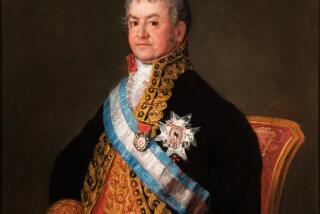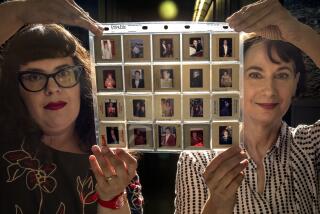It Was a Pre-Kodak Moment
- Share via
The picture was 100 years in coming. So it’s no wonder that workers stood v-e-r-y still for their first group photograph Monday in San Marino.
Employees of the Huntington Library, Art Collections and Botanical Gardens had little choice, actually. The picture was taken with the 150-year-old daguerreotype process, which uses a silver-covered copper plate, not film or pixels, to record an image.
“Don’t move!” daguerreotypist Robert Shlaer yelled before tripping the shutter on the tripod-mounted view camera aimed at about 200 workers gathered in front of him with smiles literally frozen on their faces.
“The exposure will be 20 seconds. Get comfortable. Focus your eyes on something. Your job is to hold still. We have four plates. If they don’t turn out, I’ll coat some new plates and be back in about 20 minutes.”
Shlaer, 60, of Santa Fe, is considered the premier daguerreotypist in America. Of course, Huntington officials say, there are only a few professional ones left.
Last fall, the library’s galleries featured an exhibit of Shlaer’s daguerreotypes depicting the Rocky Mountain area crossed by Gen. John C. Fremont in 1853.
The original daguerreotype images, commissioned by Fremont, were destroyed in an 1881 warehouse fire.
Huntington officials were so impressed with Shlaer’s work that they invited him to take a picture of their organization’s 360-member staff.
The only other group picture, taken in 1921, was of Henry Huntington’s 15-member, all-male professional staff, not workers such as groundskeepers and maintenance people who actually ran the 207 acres of gardens and galleries.
“The library is much more democratic these days,” said institutional archivist Dan Lewis, who on Friday will open a yearlong exhibition saluting the 100th anniversary of Huntington’s acquisition of the property.
Those able to make it for Monday’s picture waited patiently while Shlaer hurried to his battered van to process his copper-and-silver plates, which have an almost immeasurably slow film speed of ASA 0.05.
“We certainly hope he knows what he’s doing. But even after 150 years, it’s still a developing technology,” Huntington research chief Robert Ritchie joked as he waited for a possible re-shoot.
Three of the four plates were perfect. “I hope you like the way you personally turned out,” Shlaer told botanical assistant Katura Reynolds as he collected his gear. “That’s the one thing I have no responsibility for,” he said.
Everyone in the shot will get a copy in a few weeks -- but they will be computerized, not copper, said Jennifer Watts, the library’s curator of photography.
In San Marino, the daguerreotype has finally crossed the digital divide.
More to Read
Sign up for Essential California
The most important California stories and recommendations in your inbox every morning.
You may occasionally receive promotional content from the Los Angeles Times.











